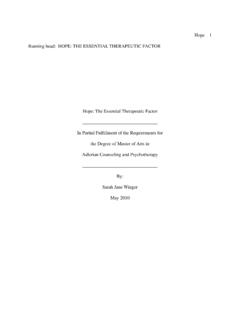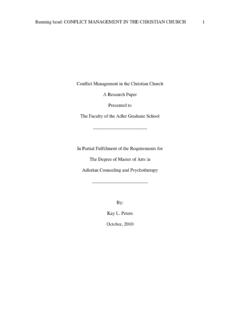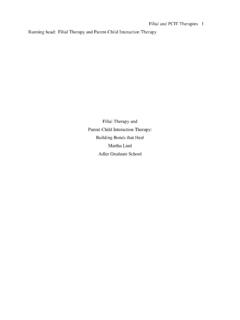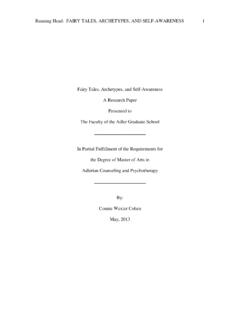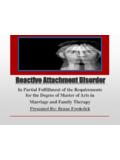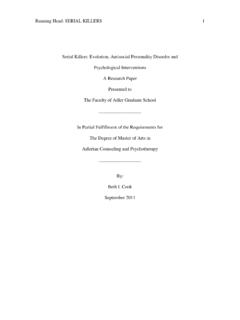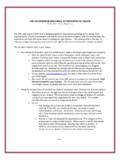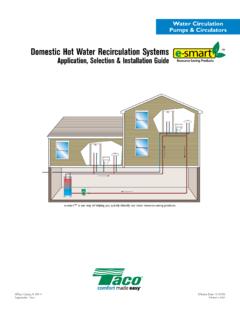Transcription of Running head: EFFECTIVE PLAY THERAPY AND …
1 Running head: EFFECTIVE play THERAPY AND ANGER 1 play THERAPY : Positive Outcomes for Youth with Anger Problems A Summary and Recommendation Paper Presented to The Faculty of the Adler Graduate School _____ In Partial Fulfillment of the Requirements for The Degree of Master of Arts in Adlerian Counseling and Psychotherapy _____ By: Danielle Livon-Bemel July, 2013 EFFECTIVE play THERAPY AND ANGER 2 Abstract There are too many kids with anger issues in society and this is proving to show difficulty in school, with peers, and in the home. A variety of behaviors are occurring, such as acting out, bullying, fighting, angry outbursts, destruction of objects, and harming self. Various forms of behavior often portrayed are: attention seeking, power, control, and revenge. This thesis will examine multiple types of anger and aggression, as well as play THERAPY techniques such as clay THERAPY , drawing and game play , role- play , and mutual storytelling that are useful to identify where anger stems from.
2 EFFECTIVE play THERAPY AND ANGER 3 Dedications To my Mom, Dad, Sister, and Brother, thank you for being my support system through out my entire graduate school career. Your love, dedication, and encouragement have molded me into the person I am today. EFFECTIVE play THERAPY AND ANGER 4 TABLE OF CONTENTS ABSTRACT 2 DEDICATIONS 3 INTRODUCTION Introduction to the Problem 6 Background of the Study 6 Statement of the Problem 6 Purpose of the Study 7 Research Question 7 Significance of the Study 7 Assumptions and Limitations 8 Definition of Terms 8 LITERATURE REVIEW Introduction 10 Anger Self-Inflicted Pain 11 Passive Anger 14 Retaliated Anger 16 Creating Anger 18 Summary 20 play THERAPY Clay THERAPY 22 Drawing and Game play 25 EFFECTIVE play THERAPY AND ANGER 5 Role- play 26 Mutual Storytelling 28 Summary 30 Child Environment Development 32 Socialization
3 And Temperament 36 Anger Regulation 38 Parent Effects 40 Parental Neglect 42 Summary 43 Final Summary 47 METHODOLOGY 52 CONCLUSIONS 53 Recommendations 56 REFERENCES 57 EFFECTIVE play THERAPY AND ANGER 6 play THERAPY : Positive Outcomes for Youth with Anger Problems Introduction to the Problem There are too many kids with anger issues in society and this is proving to show difficulty in school, with peers, and in the home. A variety of behaviors are occurring, such as acting out, bullying, fighting, angry outbursts, destruction of objects, and harming self. Each of these is forms of attention seeking, power, control, and revenge. They are problems that should be studied since they continue to negatively and interpersonally affect children to the point where it interferes with school, peers, and in the home.
4 Background of the Study This writer s interest in children and identified anger problems began when working in a group home for children who were Autistic, non-verbal, and had extremely aggressive behaviors. When clients continually became upset and angry whether it is for environmental or interpersonal reasons, this writer s interest spiked to find out and understand what types of factors led to feelings of anger and aggression. It became apparent that a common soothing mechanism to their anger was by using common ways of communicating, and play THERAPY was often a useful technique. This led to a broader view of anger in general in youth. This writer s view is that anger is not useful in communicating with others because it doesn t help the individual reach their goals in having an understandable discussion. Statement of the Problem There are various forms of anger that include but are not limited to, self-inflicted anger, passive anger and retaliated anger.
5 Among these three forms lies a common problem. Anger can lead to violence, increase in gangs, lack of education, alcoholism, drugs, and an increase in child/teenage pregnancies. Possible motives in using anger to express one s self can be correlated EFFECTIVE play THERAPY AND ANGER 7 to parents neglecting their child s emotional needs. This can also be that parents possibly have no knowledge of positive parenting styles, or parents simply work too much and see too little of their children. A process that can alleviate negative coping mechanisms associated with anger is to bring in teen or young adult mentors. These individuals are not randomly selected but are specifically identified individuals who are presently or have formally lived in the indicated city where the youth are presently living. Mentors are looking to seek change to prevent future outcomes among children with anger problems.
6 Research Question Does play THERAPY create positive outcomes in inner city youth with anger problems? Significance of the Study By studying this approach, it will be significant by showing individuals with anger issues alternative ways to deal with their anger. In doing so, they become positive healthy contributing members in society. This writer sees play THERAPY contributing to reduction of anger issues by using techniques that are child/ youth friendly, rather than using traditional anger management skills which are commonly specified for adults. These specific play THERAPY techniques are expected to lead to positive growth, maturity, and appropriate behaviors. Assumptions It is this writer s assumption there are not a lot of role models for youth. It is this writer s assumption that many youth do not learn how to properly deal with anger and emotions.
7 It is this writer s assumption that children would benefit from more structured set of behavioral guidelines. EFFECTIVE play THERAPY AND ANGER 8 Limitations Limited to a quantity of thirty research journals within contemporary academic journals only. Definition of Terms Affective arousal/deviation anxiety- Development of the ability to experience discomfort, guilt, and anxiety associated with actual or anticipated wrongdoing Aggressive- Ready or likely to attack or confront, resulting from aggression Anger- Anger will be looked at in three different ways: Passive Anger, Retaliated Anger, and Self-inflicted Pain Assertive discipline- Discipline that is forceful and can be negative Catharsis- Using aggression to improve one s state of emotion Clay manipulation- Looking for different ways an individual uses the object of clay Control- How the individual uses control related to emotions Ego- An individuals understanding of a particular feeling Emotional expression- Looking at positive emotions, as well as interpersonal emotions Emotion regulation- Looking at it in terms of keeping emotions inside or externalizing emotions Emotional stressors- Looking at the development of hostility in terms of parental and/or sibling hostility, peer interactions.
8 School Guilt- The idea of having done wrong Interpersonal emotions- Looking at whether the individual holds emotions inside and letting them build up Loss of self-esteem- Looking at whether self esteem decreases with an increase in anger EFFECTIVE play THERAPY AND ANGER 9 Physical expression- For example self-inflicted pain is used as an emotional release play THERAPY - Using clay THERAPY , drawing, and role- play Retaliated anger- Expressing anger by reciprocating onto others Role play -Type of play used to articulate, assimilate, and integrate individuals by using forms of role reversal and acting out Self-inflicted Pain- Causing physical harm to oneself by using objects or personal limbs to elicit internal emotions Social competence- Ability to communicate and interact with peers Symbolic loss- Hostility derives from the need to suffer, driven by guilt from the superego Symbolic play - Type of play expressed through imagination and fantasy Unconscious emotions- Suppressed emotions Verbal abuse- To speak in an offensive way Verbal emotions- Verbally communicating ones feelings EFFECTIVE play THERAPY AND ANGER 10 play THERAPY and Anger: Introduction Typical psychotherapy is a face-to-face interaction between a therapist and client.
9 The client sits in a chair and shares problematic issues, fears, and concerns in hopes the therapist will have a positive solution. Today, a part of psychotherapy is evolving into a play THERAPY type environment where the use of art materials or role-playing helps stimulate conversation. Younger clientele may require a more kinesthetic type THERAPY in which a therapist can help identify problem areas in ways that will not be detrimental to the child s already injured psyche. The purpose of this thesis is to find out what types of play THERAPY techniques are EFFECTIVE approaches to address anger among children. Key ideas of research involve explaining ways in which play THERAPY techniques can be facilitated for children who display physical and/or emotional stressors with anger. The study s environmental setting takes place in a THERAPY room or office that is suitable for children.
10 A child friendly environment involves sensory objects including stress balls, stretchable objects, yoga fitness balls, sensory integrated puzzles, paper and markers for drawing, clay material, plus costumes and accessories for role- play . Interest for pursuing a study on play THERAPY techniques occurred when this writer worked in a school setting with children who expressed anger in the home, school, or during interaction with peers or adults. During observation it was clear that children communicated more readily when offered to color or play with toys while communicating with a therapist. This sparked personal interest to research play THERAPY techniques that would benefit children who display angered emotions and behaviors. This thesis covers four variables and their sub topics. Anger is the independent variable whose sub topics include the creation of anger, self-inflicted pain through anger, retaliated anger, and passive anger.
